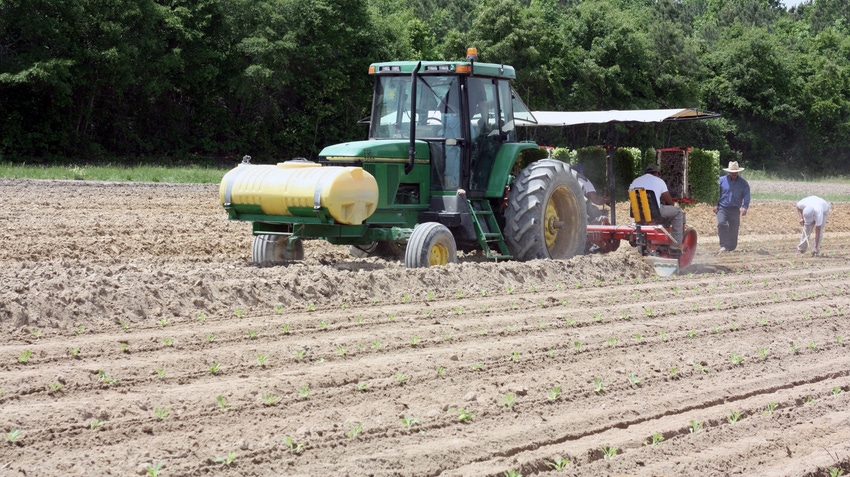May 12, 2016

Despite a rare mid-April freeze, tobacco planting got going in earnest in much of the Tobacco Belt later that month. And the government’s first production estimate suggested it would not be the sharply reduced crop that had been expected by many.
In its Prospective Plantings Report issued March 30, USDA said acreage of the two major tobacco types — and most of the minor types — would change only modestly and for some types not at all from last year. According to this projection:
Flue-cured acreage will be four percent below 2015 at 209,000 acres.
Burley acreage will be up slightly at 79,150 acres.
Fire-cured acreage will be down two percent at 17,350 acres.
Dark air-cured acreage will be down four percent at 5,950 acres.
Southern Maryland acreage will be unchanged from last year at 1,600 acres.
Pennsylvania Seedleaf acreage will be down 12 percent at 1,400 acres.
Cigar leaf acreage in Connecticut and Massachusetts will be up four percent at 2,900 acres.
In North Carolina, the leading tobacco state, planting got up to full speed along the Interstate 95 corridor the week ending April 23.
“Some growers tried to start the week before, but the cold temperatures the night of April 9 followed by a rain a few days later slowed things for a few more days,” said Matthew Vann, North Carolina Extension tobacco specialist. “Now, everyone is rocking and rolling.”
Greenhouse growing conditions had been good. “There was a little disease at the end but not anything extremely concerning,” said Vann. “We are in good shape in terms of plant availability and quality.”
It was a good greenhouse season too in south central Virginia, said Chris Haskins of Chatham, near Danville.
"I will have to mow my plants by the end of this week," said Haskins, who grows flue-cured and burley, on April 4. "They are ahead of schedule now thanks to all the sunshine and warm weather we had in March. We didn't have much wind then, but it is blowing now."
He seeded his house on March 8 and planned on starting planting by the end of April, if not sooner. He planned on growing 36 acres of flue-cured and 13 of burley.
The mid-April freeze in South Carolina
"Only a small percentage of our total tobacco acreage had been transplanted by April 9," said William Hardee, S.C. Extension agent for Horry and Marion counties. "But for some, this will turn out to be a costly incident."
Some fields were damaged to the extent that the field had to be reset completely. Re-pegging to replace dead transplants was enough in other fields.
The damage seemed worse on the light/sandy soils, Hardee says. That indicates that the cold, hard winds could have been a major contributor to the damage in addition to the low temperatures.
For most of the rest of the Tobacco Belt, the freeze came too early and wasn’t quite cold enough to be very damaging.
In Tennessee it got cold the weekend of April 9, but all the tobacco there was still in the greenhouse and no damage was reported. In Macon County, Tenn., just northeast of Nashville, Keith Allen, county Extension tobacco agent said, "The low temperature was closer to 40 than to freezing."
All plants were in houses at the time, although some had been removed from the greenhouses in which they were grown and floated in outside water beds, a tactic used in this county to free up greenhouse space for seeding a second crop. Again, no damage was reported.
In east Tennessee, Richard Hensley, a research associate at the University of Tennessee Research Center in Greeneville, said, "The only effect I noticed was that the plants growing close to the curtains looked a little small (after the cold) compared to the ones in the middle of the houses. I think that effect may be associated with the temperature.”
A little farther west, in Robertson County, the first incidence of target spot was confirmed in greenhouse tobacco plants in mid-April, said Paul Hart, county Extension agent.
“Overall, tobacco plant production is progressing well and on schedule,” he said.
When Southeast Farm Press interviewed Allen on April 18, he said many Macon County growers were champing at the bit to start transplanting.
"Some of our plants have been mowed two or three times and they are ready to go out," he said.
In other tobacco news:
Transplanting began March 14 in Florida and Georgia. Higher-than-normal temperatures for that time of year helped farmers in the Deep South get a good start, said Extension Specialist J. Michael Moore.
Blue mold had been identified in six greenhouses in Georgia through the Easter weekend. No instances of the fungal disease moving from greenhouses to fields on transplants had been observed, but growers were warned to be on the lookout.
In Kentucky, the value of all tobacco production will likely fall below $350 million in 2015 and 2016 after a post‐buyout high level of $448 million in 2014, according to a report from the University of Kentucky department of agricultural economics.
The U.S. Tobacco Cooperative in Raleigh, N.C., will operate a new leaf marketing center this season in LaCrosse, Va., near South Hill. It will continue to operate marketing centers in Nashville, Ga.; Mullins, S.C.; Sanford, N.C.; Smithfield, N.C. and Wilson, N.C. It has closed centers in Oxford, N.C., and Danville, Va.
About the Author(s)
You May Also Like




